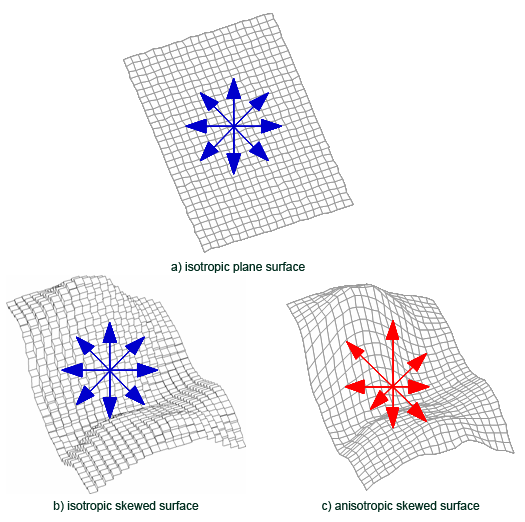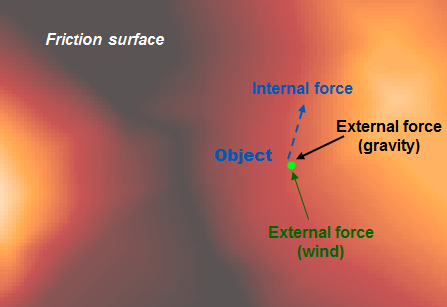|
|
Accessibility and movements in space
When combining the spatial and temporal dimensions, it is then possible to model trajectories in space. The modelling of trajectories concerns the type of moving features –people or goods- throughout space, with the means of transportation, as well as with the way space is modelled.
We already have identified three major levels of a model of space (I-AN, 1. Introduction to Intermediate Spatial Analysis, Section 1.2), from a “simple” homogeneous surface to a heterogeneous surface with anisotropic properties:
- As an
 isotropic plane surface: space is simply considered as a
homogeneous surface with thematic property distribution only ruled by
Euclidian geometry (linear plane distance influencing accessibility,
proximity and dependency).
isotropic plane surface: space is simply considered as a
homogeneous surface with thematic property distribution only ruled by
Euclidian geometry (linear plane distance influencing accessibility,
proximity and dependency). - As an
 isotropic skewed surface: space is considered as a heterogeneous
surface with each location influencing differently the distribution of
thematic properties as well as the proximity and the accessibility. Space is
modelled as a skewed surface expressing an individual “isotropic friction
rate” at each location. Distance is therefore no longer linear but
symmetrical.
isotropic skewed surface: space is considered as a heterogeneous
surface with each location influencing differently the distribution of
thematic properties as well as the proximity and the accessibility. Space is
modelled as a skewed surface expressing an individual “isotropic friction
rate” at each location. Distance is therefore no longer linear but
symmetrical. - As an
 anisotropic skewed surface: space is considered as a heterogeneous
surface but with an individual “anisotropic friction rate” at each location.
Distance is therefore no longer linear nor symmetrical.
anisotropic skewed surface: space is considered as a heterogeneous
surface but with an individual “anisotropic friction rate” at each location.
Distance is therefore no longer linear nor symmetrical.
 Modelling spatial properties in different manners
Modelling spatial properties in different manners
When space is modeled with both geometric and thematic dimensions, it is then possible to model movements and trajectories
in this space in a more complex, but more realistic, manner.
Spatial dynamics models share some common concepts. From already discussed diffusion models, we will retain two basic concepts
for modeling ![]() accessibility and
accessibility and ![]() movements in space:
movements in space: ![]() barriers and
barriers and ![]() friction.
In reality, space is experienced as an environment with heterogeneous properties with respect to movement. Each place retains
or favours a variable rate of movement with moving features. This is modelled with the concept of friction. In extreme situations
movement is strictly restricted within a network, such as road networks. Any other location in this space is inaccessible,
acting as an impermeable barrier to movement; its friction is infinite.
friction.
In reality, space is experienced as an environment with heterogeneous properties with respect to movement. Each place retains
or favours a variable rate of movement with moving features. This is modelled with the concept of friction. In extreme situations
movement is strictly restricted within a network, such as road networks. Any other location in this space is inaccessible,
acting as an impermeable barrier to movement; its friction is infinite.
Spatial dynamics models share some common concepts. From already discussed diffusion models, we will retain two basic concepts for modeling accessibility and movements in space: barriers and friction.
In reality, space is experienced as an environment with heterogeneous properties with respect to movement. Each place retains or favours a variable rate of movement with moving features. This is modelled with the concept of friction. In extreme situations movement is strictly restricted within a network, such as road networks. Any other location in this space is inaccessible, acting as an impermeable barrier to movement; its friction is infinite.
Major concepts applied in movement models:
 Forces of movement: Energies allowing the movement of mobile features. Forces can be internal to the feature, giving it autonomous mobility
and great flexibility to choose the direction of movement. Movement of a feature can also be generated or influenced by external
forces such as gravity, wind or more general attraction forces. They can be either directional (anisotropic) or non-directional
(isotropic). Internal and external forces can be simultaneously present, but according to their relative influence situations
they can be classified into two groups:
active movement for features with important internal forces (auto-mobility) and passive movement for features mainly moved
by external forces.
Forces of movement: Energies allowing the movement of mobile features. Forces can be internal to the feature, giving it autonomous mobility
and great flexibility to choose the direction of movement. Movement of a feature can also be generated or influenced by external
forces such as gravity, wind or more general attraction forces. They can be either directional (anisotropic) or non-directional
(isotropic). Internal and external forces can be simultaneously present, but according to their relative influence situations
they can be classified into two groups:
active movement for features with important internal forces (auto-mobility) and passive movement for features mainly moved
by external forces. Frictions of space: Specific properties at any location in space can slow down a movement at varying degrees of intensity.
However, this concept of friction can be extended to any influence on the movement and can therefore incorporate the concept
of force.
Influence can be split into three situations: a slow down effect, no effect and an accelerative effect.
The property of directional variability can then be added to these friction characteristics with variable positive or negative
effects,
depending on the model of space in use.
Frictions of space: Specific properties at any location in space can slow down a movement at varying degrees of intensity.
However, this concept of friction can be extended to any influence on the movement and can therefore incorporate the concept
of force.
Influence can be split into three situations: a slow down effect, no effect and an accelerative effect.
The property of directional variability can then be added to these friction characteristics with variable positive or negative
effects,
depending on the model of space in use. Temporal variability: Depending on the level of complexity of the selected model, the temporal variability of forces,
friction, and also direction can be integrated into the modelling process.
One should remember that we are dealing with dynamic processes in which effects are varying throughout time.
Temporal variability: Depending on the level of complexity of the selected model, the temporal variability of forces,
friction, and also direction can be integrated into the modelling process.
One should remember that we are dealing with dynamic processes in which effects are varying throughout time. Cost distance: When properties of space are taken into account with the concept of friction, then the Euclidian distance that was used
to express proximity within a plane surface, should be replaced by a broader concept called Cost distance. As opposed to the
plane distance that uses metric units, the cost distance expresses the amount of resources spent while moving from one place
of space to another. Units of measurement can then express an amount of time, energy, financial resources, or any other type
of resource. Cost distance is also called weighted distance, as the geometric distance is weighted by friction coefficients.
Cost distance: When properties of space are taken into account with the concept of friction, then the Euclidian distance that was used
to express proximity within a plane surface, should be replaced by a broader concept called Cost distance. As opposed to the
plane distance that uses metric units, the cost distance expresses the amount of resources spent while moving from one place
of space to another. Units of measurement can then express an amount of time, energy, financial resources, or any other type
of resource. Cost distance is also called weighted distance, as the geometric distance is weighted by friction coefficients. Path, trajectory: The modelled path or the trajectory of movement from one place to another corresponds to the itinerary that optimises the
considered resource according to the friction surface and the active forces. It is often called the optimal path, but might
not be unique, particularly in an open space modelled in a raster structure.
Path, trajectory: The modelled path or the trajectory of movement from one place to another corresponds to the itinerary that optimises the
considered resource according to the friction surface and the active forces. It is often called the optimal path, but might
not be unique, particularly in an open space modelled in a raster structure.
 Major components influencing the movement in space
Major components influencing the movement in space